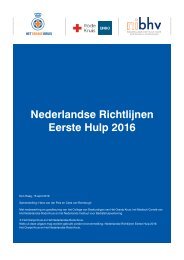Thesis-Anne-Vos-Masters-SBR-and-EU-Law-3
Thesis-Anne-Vos-Masters-SBR-and-EU-Law-3
Thesis-Anne-Vos-Masters-SBR-and-EU-Law-3
You also want an ePaper? Increase the reach of your titles
YUMPU automatically turns print PDFs into web optimized ePapers that Google loves.
(anymore). 384 The principle could be seen as a concretization of the prevention principle: it can only<br />
be applicable if there are clear sources of pollution (puntbronnen). Moreover, it is applied in a later<br />
stage than the prevention principle; while the prevention principle will try to prevent pollution in<br />
advance (by e.g. taking technical measures), the rectification at the source-principle will implicates<br />
that pollution has already occurred (or is occurring) after which measures will be taken to prevent<br />
<strong>and</strong> restrict the pollution as much as possible (from the source). It is often questioned whether the<br />
rectification at the source should not be interpreted stricter in order to prevent the pollution entirely.<br />
In <strong>EU</strong> legislation, this principle can mainly be found in the Industrial Emissions Directive. In <strong>EU</strong><br />
legislation it is often stated, with reference to this principle, that emission norms are preferred<br />
above quality requirements. 385 With regard to shale gas, it can be argued that the rectification at<br />
the source principle is not (yet) applicable, since shale gas extraction has not (yet) occurred. The<br />
later stage in which the rectification at the source principle can be of relevance is not entered into.<br />
It is currently better in place to focus on prevention instead of curing at the source. There is nothing<br />
(yet) to cure, but there is already a lot to prevent.<br />
5.7.2 Dutch level<br />
In Dutch legislation there is not an explicit reference to or a definition of the prevention principle<br />
included. While the precautionary principle mostly came alive through case law, the prevention<br />
principle gets most of its interpretation through laws, regulation <strong>and</strong> policy documents of which it is<br />
the underlying objective. Some articles herein implicitly refer to the prevention principle. 386 There<br />
can be made a distinction between material <strong>and</strong> procedural regulations. Article 1.1a of the<br />
Environmental Management Act (Wet milieubeheer) includes a general duty of care <strong>and</strong> is an<br />
example of a procedural regulation of the principle. It states that anyone who knows or reasonably<br />
suspects that by his acts or omissions detrimental effects on the environment can be caused, is<br />
required to desist from such action to the extent that can be reasonably dem<strong>and</strong>ed, or to take<br />
measures that could reasonably be expected of him in order to prevent such consequences, or, to<br />
the extent that these consequences cannot be avoided, to minimize it as much as possible or to<br />
undo all measures. Other duties of care also have this principle as its underlying aim, such as the<br />
ones included in the Soil Protection Act (Article 13) or the Water legislation. References can also<br />
be found in other articles of the Environmental Management Act. 387 Art. 2.22 Wabo contains<br />
several environmental quality requirements that have to be reviewed before granting a license.<br />
This is a material application of the principle. The prevention principle is also important for Chapter<br />
7 of the Environmental Management Act, concerning the EIA, which is a (clear) procedural<br />
appearance of the principle in regulation. All of these regulations should be taken into account<br />
when making a decision. If aspects are forgotten, the decision will be annulled; on ground of the<br />
legislation itself or due to an infringement of Article 3:2 Awb on careful decision-making.<br />
Most of the Dutch case law, which implicitly touches upon the prevention principle, concerns cases<br />
on this regulation, e.g. on the application of EIA, discharges of waste, <strong>and</strong> IPPC-establishments<br />
<strong>and</strong> their use of the BAT <strong>and</strong> compliance with the Industrial Emission Directive, of which the<br />
prevention principle is one of the underlying objectives. In none of these Dutch cases is the<br />
principle independently used or is special attention paid to the prevention principle, nor is the<br />
scope of the principle discussed. 388 The principle is always debated in the context of the national<br />
laws <strong>and</strong> regulations of which it is the underlying principle. Hence, it seems from the Dutch <strong>and</strong><br />
European case law that the principle itself is not explicitly part of the court's review, but the<br />
Directives <strong>and</strong> national law that prescribe preventive measures to be taken is central. Parties,<br />
competent authorities <strong>and</strong> courts should be aware that certain Directives have direct effect in the<br />
384<br />
Fennis (2012), p. 29.<br />
385<br />
Fennis (2012), p. 56.<br />
386<br />
Backes et al. (2002), pp. 86-89.<br />
387<br />
See e.g. Art. 5.1(2), Art. 8.11(3) (now Article 2.22 jo. Art. 1.1 of the Environmental Permitting (General Provisions) Act),<br />
Art. 8.8(1)(e), Art. 8.40(2)(d), Art. 8.49 <strong>and</strong> Art. 10.1.<br />
388<br />
Fennis (2012), p. 51.<br />
75



